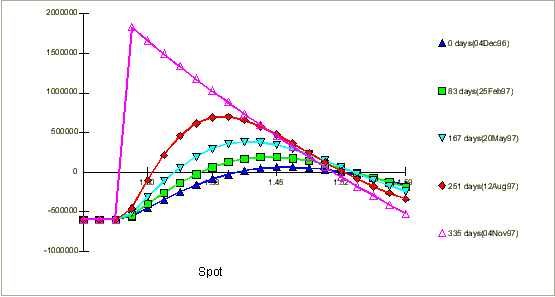Use KnockOut Options To Lower The Cost of Hedging
Post on: 16 Март, 2015 No Comment

A knock-out option belongs to a class of exotic options – options that have more complex features than plain-vanilla options – known as barrier options. Barrier options are options that either come into existence or cease to exist when the price of the underlying asset reaches or breaches a pre-defined price level within a defined period of time. Knock-in options come into existence when the price of the underlying asset reaches or breaches a specific price level, while knock-out options cease to exist (i.e. they are knocked out) when the asset price reaches or breaches a price level. The basic rationale for using these types of options is to lower the cost of hedging or speculation.
Basic features of knock-out options
There are two basic types of knock-out options:
- Up-and-out – The price of the underlying asset has to move up through a specified price point for it to be knocked out.
- Down-and-out – The price of the underlying asset has to move down through a specified price point for it to be knocked out.
Knock-out options can be constructed using either calls or puts. Knock-out options are over-the-counter (OTC) instruments and do not trade on option exchanges, and are more commonly used in foreign exchange markets than equity markets.
Unlike a plain-vanilla call or put option where the only price defined is the strike price. a knock-out option has to specify two prices – the strike price and the knock-out barrier price.

The following two important points about knock-out options need to be kept in mind:
- A knock-out option will have a positive payoff only if it is in-the-money and the knock-out barrier price has never been reached or breached during the life of the option. In this case, the knock-out option will behave like a standard call or put option.
- The option is knocked out as soon as the price of the underlying asset reaches or breaches the knock-out barrier price, even if the asset price subsequently trades above or below the barrier. In other words, once the option is knocked out, it’s out for the count and cannot be reactivated, regardless of the subsequent price behavior of the underlying asset.
(Note: In these examples, we assume that the option is knocked out upon a breach of the barrier price).
Consider a stock that is trading at $100. A trader buys a knock-out call option with a strike price of $105 and a knock-out barrier of $110, expiring in three months, for a premium payment of $2. Assume that the price of a three-month plain-vanilla call option with a strike price of $105 is $3.
What is the rationale for the trader to buy the knock-out call, rather than a plain-vanilla call? While the trader is obviously bullish on the stock, he/she is quite confident that it has limited upside beyond $105. The trader is therefore willing to sacrifice some upside in the stock in return for slashing the cost of the option by 33% (i.e. $2 rather than $3).
Over the three-month life of the option, if the stock ever trades above the barrier price of $110, it will be knocked out and cease to exist. But if the stock does not trade above $110, the trader’s profit or loss depends on the stock price shortly before (or at) option expiration.
If the stock is trading below $105 just before option expiration, the call is out-of-the-money and expires worthless. If the stock is trading above $105 and below $110 just before option expiration, the call is in-the-money and has a gross profit equal to the stock price less $105 (the net profit is this amount less $2). Thus, if the stock is trading at $109.80 at or near option expiration, the gross profit on the trade is equal to $4.80.
The payoff table for this knock-out call option is as follows –














